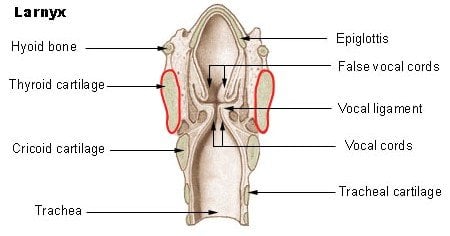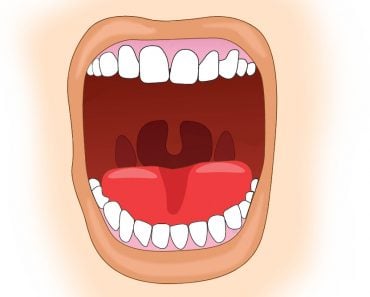Table of Contents (click to expand)
The Adam’s apple is actually a chunk of bony cartilage that surrounds the larynx, i.e., the voice box. The reason it’s more prominent in men than in women is because during puberty, a man’s voice box tends to grow in size (much more than in women), so a noticeable bump appears right in the middle of the throat.
With a cursory glance at an infant, not everyone can tell whether it’s a boy or girl.
Both the male and female bodies look quite similar at the outset and only develop several physical attributes that easily differentiate them as we age.
One noticeable change is what we call the “Adam’s Apple.” After puberty, young men now lump in their throats while women don’t. Why do men, not women, develop an “Adam’s Apple”? But before that…
Recommended Video for you:
Why Does The “Adam’s Apple” Have That Name?
Almost all of our body parts have names that ‘sound’ biological: brain, heart, lungs, stomach, kidneys, etc. They probably sound so because we commonly refer to them, and they all have Greek, Latin, or Germanic origins, which we associate with science. A colloquial-sounding Adam’s apple then stands out (besides the fact there’s a fruit in the name).

The name Adam’s apple comes from the biblical reference of a piece of forbidden fruit getting stuck in Adam’s throat. The Bible says that God had forbidden Adam and Eve from eating fruit that grew in the Garden of Eden. Yet, Adam ends up eating the fruit, which popular imagery shows as an apple.
The Scientific Reason Behind The Adam’s Apple
In scientific terminology, the Adam’s apple is called the laryngeal prominence.
The larynx is located at the top of the neck, in the upper parts of the airway, the trachea. The larynx is involved in breathing, protecting the trachea from food stuck down the throat, and producing sound. The larynx is also your voice box containing your vocal cords.

Cartilage protects the larynx by nine pieces. One of these nine pieces is the thyroid cartilage located at the top part of the throat. The thyroid cartilage pinches upward, causing a protrusion. That protrusion is called the laryngeal prominence, a.k .a. your Adam’s apple.
Now, we all have a larynx and thyroid cartilage and laryngeal prominence (except for certain birth defects or injury to the organ), regardless of sex.
The laryngeal prominence is visible from the outside in men because of the effects of the puberty hormone cocktail, mainly testosterone, coursing through their veins. The larynx grows in size, and so does the thyroid cartilage.
A larger voice box is why men have deeper voices than women. For some men, their voices can drop down an octave.

Women Find Deeper Voices Sexy.
Anyone would swoon hearing the voice of Johnny Cash, Barry White, Leonard Cohen, or, more recently, George Ezra. Their deep, luscious voices have a distinctly sexy quality about them. Anthropologists (researchers who study human culture and its evolution) asked what effect deep voices have on us.
Deep voices are associated with being stronger and more aggressive. It turns out that men with deeper voices tend to be taller and stronger. A deep voice, then, acts as sexual selection, indicating to those around that the man has good, healthy genetics. Men in the Hadza tribe who had deeper voices were thought to be better hunters by their fellow tribesmen.
But women also perceive men with deeper voices to be less faithful.
The Adam’s Apple In Women
Females produce less testosterone, so, on average, the larynx doesn’t grow as much as it does in men. Additionally, there is a difference in the shape of the laryngeal prominence in males and females.
In males, the sides of the laryngeal prominence protrude at an almost 90° angle, while in females, it is at a more obtuse 120° angle, making it appear less visible. You can even feel your Adam’s apple moving as you swallow by placing your hand where your neck begins.

But, a female can have a prominent Adam’s apple. This could be due to genetic factors, factors related to the hormones during puberty, or a medical condition. It is possible to make the laryngeal prominence less visible (without affecting the voice). This procedure is called a laryngeal shave or chondrolaryngoplasty.
Trans men taking testosterone may get an Adam’s apple from the influence of the testosterone on the larynx and the cartilage. But, for trans men who do wish to get an Adam’s apple but the hormones aren’t working, there is a surgical procedure to construct an Adam’s apple.
Last Updated By: Salama Yusuf
References (click to expand)
- https://web.archive.org/web/20170105195807/http://www3.uakron.edu/witt/adol/gender.htm
- Anatomy, Head and Neck: Adam's Apple - StatPearls.
- Deschamps-Braly, J. C., Sacher, C. L., Fick, J., & Ousterhout, D. K. (2017, April). First Female-to-Male Facial Confirmation Surgery with Description of a New Procedure for Masculinization of the Thyroid Cartilage (Adam’s Apple). Plastic & Reconstructive Surgery. Ovid Technologies (Wolters Kluwer Health).
- Coleman, L., Zakowski, M., Gold, J. A., & Ramanathan, S. (2013). Functional Anatomy of the Airway. Benumof and Hagberg's Airway Management. Elsevier.
- Schild, C., Stern, J., Penke, L., & Zettler, I. (2020, October 16). Voice Pitch – A Valid Indicator of One’s Unfaithfulness in Committed Relationships?. Adaptive Human Behavior and Physiology. Springer Science and Business Media LLC.
- Smith, K. M., Olkhov, Y. M., Puts, D. A., & Apicella, C. L. (2017, October 1). Hadza Men With Lower Voice Pitch Have a Better Hunting Reputation. Evolutionary Psychology. SAGE Publications.
- Schild, C., Aung, T., Kordsmeyer, T. L., Cardenas, R. A., Puts, D. A., & Penke, L. (2020, December 4). Linking human male vocal parameters to perceptions, body morphology, strength and hormonal profiles in contexts of sexual selection. Scientific Reports. Springer Science and Business Media LLC.













